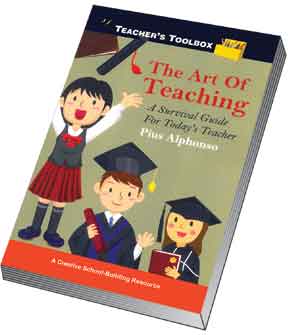Cheryl Rao
Teachers are entrusted with igniting the fire of learning in their students’ minds and keeping it alive. In doing so they make a lasting impression on the young minds in their care. But in the light of the growing challenges faced by the teaching profession in the 21st century, many believe that the teaching styles of the past are not practicable. In this new scenario, is there a teacher who does not feel beleaguered at some time during the academic year? A teacher who does not question the efficacy of his/her classroom management and methods of student motivation? A teacher who does not doubt his/her role as guide, counsellor, leader and a person with a positive influence on the students?
 Pius Alphonso starts the first chapter of his book with Donald D. Quinn’s words: “If a doctor, lawyer, or dentist had 40 people in his office at one time, all of whom had different needs and some of whom didn’t want to be there and were causing trouble and the doctor, lawyer or dentist, without assistance, had to treat them all with professional excellence for nine months, then he might have some conception of the classroom teacher’s job.” At once, the reader understands that the author has had experience of a typical classroom in a typical school – and having had the experience, is determined to help teachers build an atmosphere in the classroom where enthusiasm does not flag and where both the teacher and the student learn to respect each other and benefit from the experience.
Pius Alphonso starts the first chapter of his book with Donald D. Quinn’s words: “If a doctor, lawyer, or dentist had 40 people in his office at one time, all of whom had different needs and some of whom didn’t want to be there and were causing trouble and the doctor, lawyer or dentist, without assistance, had to treat them all with professional excellence for nine months, then he might have some conception of the classroom teacher’s job.” At once, the reader understands that the author has had experience of a typical classroom in a typical school – and having had the experience, is determined to help teachers build an atmosphere in the classroom where enthusiasm does not flag and where both the teacher and the student learn to respect each other and benefit from the experience.
Alphonso does not mince words. “If you don’t like to teach, evaluate your choice of profession”, is one of the first bits of advice he gives, but along with it, he makes sure to underline that bad days happen to all of us and as teachers it is up to us to evaluate whether these are the exceptions or the rule. He then runs through the qualities that make a great teacher, reveals some of the ‘trade secrets’ to transform a dull classroom into a centre of fun and learning, highlights strategies for effective teaching, etc. He also devotes a full chapter to value education, which we sorely need in our quest to build a better world.
Beginning each chapter with well-chosen quotations, the author tackles the problems of self-motivation for the teacher, building a beneficial teacher-parent relationship, motivating the student, and imparting study skills so that students acquire an edge in the adult world they will be entering.
This survival guide could have had more examples so that beleaguered teachers, short on time, could flip through and find hints to tide them through a difficult situation, but is this what is really required? There is no ‘how-to’ book that can cover every circumstance faced by a teacher – something new will always come up and it is for the individual teacher to find what works in each situation.
Where this book scores is in inspiring and prompting the teacher to think out of the box to foster a dynamic classroom environment that will bring out the best in students, reinforcing John Cotton Dana’s words, “Who dares to teach must never cease to learn.”
Appropriately included in the Teacher’s Toolbox series, The Art of Teaching is a book teachers can return to again and again, at each stage gleaning a few words of wisdom to inspire and stimulate them to face the challenges before them.
The author is a writer and conducts/facilitates creative writing workshops for children. She can be reached at cherbrag@yahoo.com.
